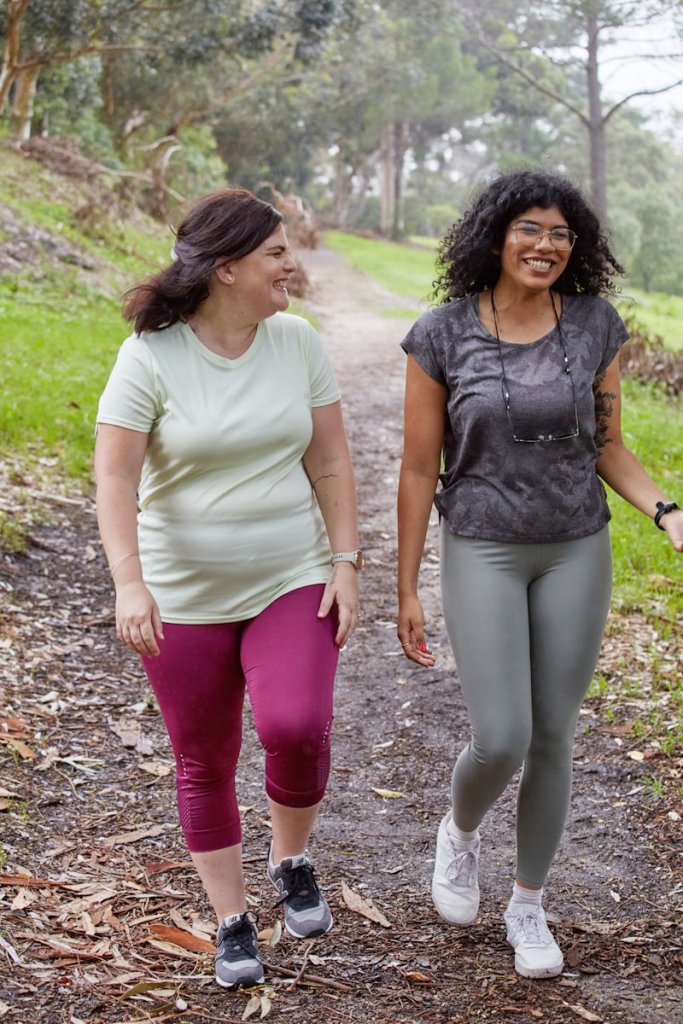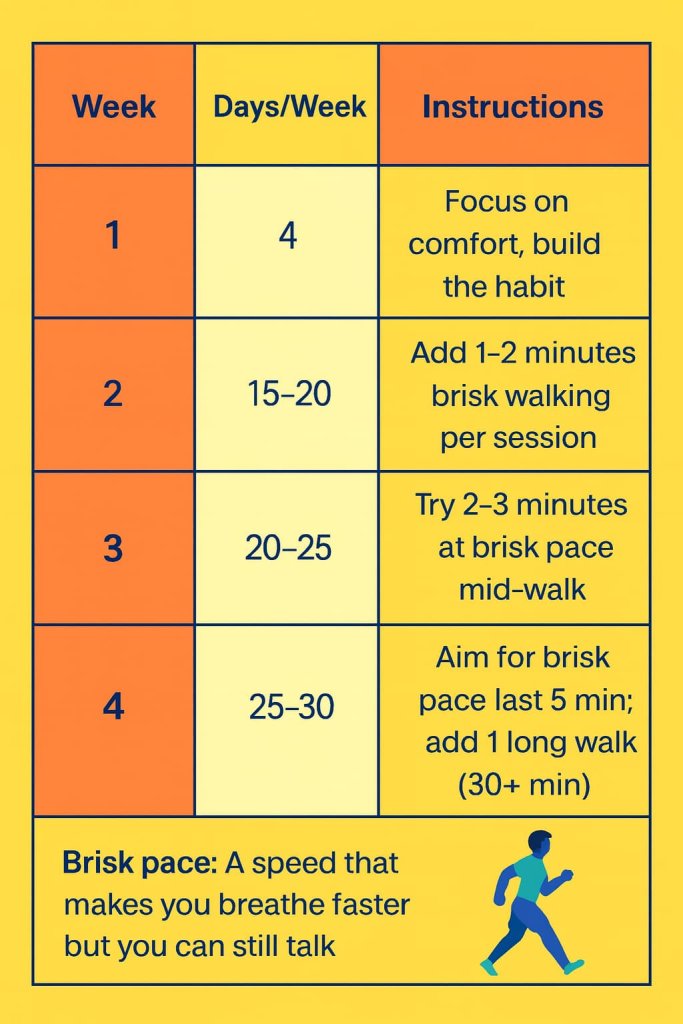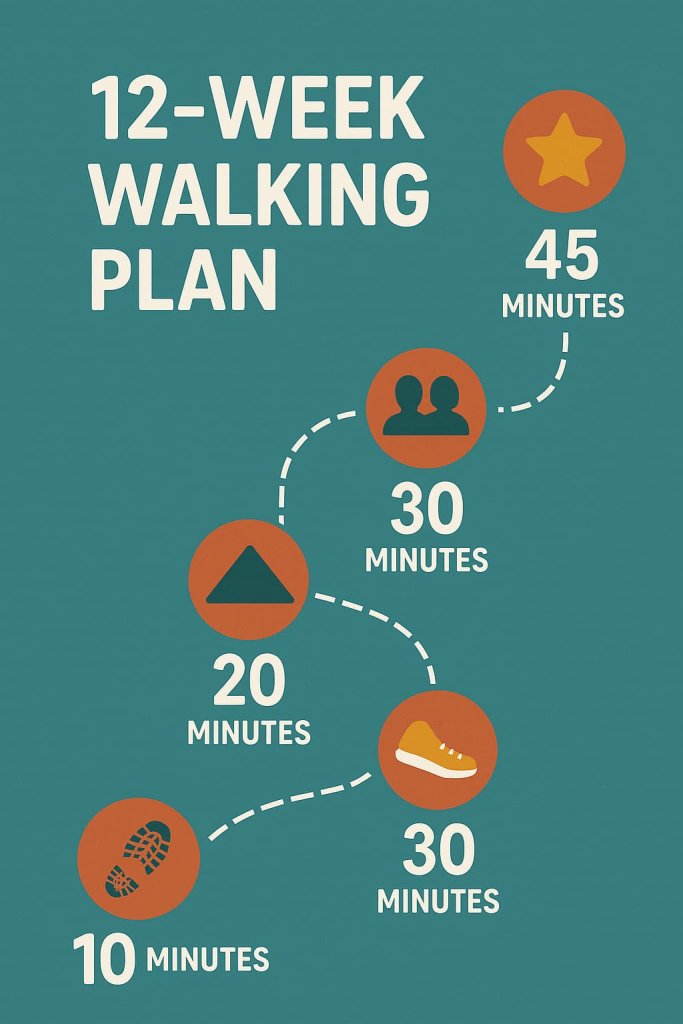A walking plan for beginners is one of the safest and most effective ways to start building fitness and improving your health—no matter your age, body type, or experience level. Just 15 to 30 minutes of structured walking a day can significantly boost your cardiovascular health, help with weight management, reduce stress, and set the foundation for long-term healthy habits.

Understanding the right plan and schedule is essential because starting too fast or without a plan often leads to burnout or injury. In this guide, you’ll get a step-by-step system: how to start walking, weekly and monthly progressions, tips to stay motivated, and the science behind why walking is so powerful. For more official advice, see the CDC’s Physical Activity Basics.
Why Start a Walking Plan? (Science & Benefits)
Walking is consistently ranked as the #1 beginner exercise by major health organizations. Here’s why:
- Reduces the risk of heart disease: Just 21 minutes a day can cut your risk of heart disease by 30% (Harvard Health, 2024).
- Boosts mood and mental health: Walking triggers the release of endorphins and serotonin, lowering anxiety and depression levels.
- Supports weight loss and management: Even moderate-paced walking helps burn calories and fat without straining joints.
- Strengthens muscles, joints, and bones: Walking is a weight-bearing activity that improves bone density and strengthens legs, hips, and back.
- Improves sleep quality: People who walk regularly report better and deeper sleep.
Recent Data (2025):
A 2025 JAMA meta-analysis found that walking at least 7,000 steps daily reduced the risk of premature death by 20–30% for adults over 40 (JAMA Network Open, April 2025). Even less can be beneficial if you’re consistent.
Real-World Example:
A beginner who walked 20 minutes a day for three months improved their resting heart rate and lost 5–8 pounds without changing their diet.
How to Start: Key Tips for Beginners
Walking Plan and Schedule for Beginners: Getting Started
- Get Medical Clearance: If you have chronic illnesses, are pregnant, or haven’t exercised in years, check with your healthcare provider before starting.
- Pick the Right Shoes: Good walking shoes have arch support, cushioning, and fit well. Blisters or foot pain can derail your new habit.
- Dress for Comfort: Choose breathable clothes and consider moisture-wicking socks.
- Schedule Your Walks: Decide on a regular time—morning, lunch break, or evening—to build consistency.
- Start With a Warm-Up: Begin each walk with 3–5 minutes of gentle movement and dynamic stretching (ankle rolls, marching in place).
- Cool Down & Stretch: After each walk, slow down for 3–5 minutes and gently stretch calves, quads, and hamstrings.
- Track Your Progress: Use a free app (Google Fit, Apple Health), a basic pedometer, or simply a paper log.
Tip: Listen to your body. Mild muscle soreness is normal, but pain is a warning sign.
What Is the Best Beginner Walking Schedule?
There’s no one-size-fits-all—but all beginner schedules have three core principles:
- Start small and progress slowly
- Be consistent (4–6 days per week)
- Mix in rest or “easy” days to recover
Sample Walking Schedules for Beginners
4-Week Walking Plan for Complete Beginners

Goal: Safely build up from 10 minutes/day to 30 minutes/day.
| Week | Days/Week | Minutes/Day | Instructions |
|---|---|---|---|
| 1 | 4 | 10–15 | Focus on comfort, build the habit |
| 2 | 5 | 15–20 | Add 1–2 minutes brisk walking per session |
| 3 | 5 | 20–25 | Try 2–3 minutes at brisk pace mid-walk |
| 4 | 5–6 | 25–30 | Aim for brisk pace last 5 min; add 1 long walk (30+ min) |
Brisk pace: A speed that makes you breathe faster but you can still talk (usually 3–4 mph).
Weekly Example:
- Mon, Wed, Fri, Sat: 15 minutes easy walking
- Sun: Optional family or social walk
- Tues, Thurs: Rest or 5–10 min gentle stretching
6-Week Progressive Walking Schedule
Ideal for those who want a gradual build-up or are returning after injury/illness.
| Week | Frequency | Duration | Focus |
|---|---|---|---|
| 1 | 4x/week | 10 min | Get moving, low effort |
| 2 | 5x/week | 15 min | Slightly longer, maintain easy pace |
| 3 | 5x/week | 20 min | Add 2 brisk intervals (1–2 min each) |
| 4 | 5x/week | 25 min | Increase brisk walking to 5+ min total |
| 5 | 6x/week | 25–30 min | One walk includes 10 min brisk pace |
| 6 | 6x/week | 30–35 min | Try for 15 min at brisk pace in one walk |
Rest Days: Focus on recovery—stretch, foam roll, or take a short walk for circulation.
12-Week Walking Plan (Building a Lifelong Habit)

Why 12 weeks? Studies show it takes about 66 days to form a lasting habit.
- Weeks 1–4: Build up to 30 minutes/day, 5–6 days/week. Focus on consistency.
- Weeks 5–8: Add variety: brisk intervals, hills, different routes. Try for 7,000–8,000 steps/day.
- Weeks 9–12: Increase to 40–45 minutes if comfortable, aim for 10,000 steps/day. Invite friends, join a group, or try virtual walking challenges.
Tracking Progress: Most smartwatches, phones, or step counters make tracking easy—aim for gradual increases, not perfection.
How to Make Walking a Habit (and Stick With It)
- Put It on Your Calendar: Treat walks like any appointment. Set a phone alarm or calendar reminder.
- Social Support: Invite a friend, family member, or coworker. Studies show we’re more likely to stick to walking when we’re accountable to others (Harvard Health, 2024).
- Reward Yourself: Celebrate milestones (first week, first month, 50th walk) with something positive: a new audiobook, walking socks, or a special snack.
- Mix It Up: Try new routes, music, nature trails, podcasts, or “walk and talk” meetings.
- Track, Reflect, Repeat: Logging your walks (in an app, journal, or step counter) helps visualize progress and keeps motivation high.
Example Habit Loop: Wake up → Put on shoes → Walk for 20 minutes → Mark calendar → Reward (coffee, podcast).
Common Mistakes Beginners Make (and How to Avoid Them)
- Doing too much, too soon: Trying to walk 60+ minutes on day 1 leads to burnout or injury. Always build gradually.
- Wearing the wrong shoes: Old or unsupportive shoes can cause blisters, shin splints, or knee pain. Invest in proper walking shoes!
- Ignoring pain: Soreness is normal, but sharp pain means you should stop and rest.
- Skipping rest or recovery: Your body needs time to adapt. Use rest days for gentle movement or stretching.
- Getting bored: Change scenery, listen to music, or invite someone to join you to keep things fresh.
- Setting unrealistic goals: Start with what fits your life—consistency beats intensity at the beginning.
Frequently Asked Questions (FAQ) About Beginner Walking Plans
Q: How do I know if I’m walking at the right intensity?
A: Aim for a pace where you can talk, but not sing. If you’re breathing a bit harder but still comfortable, you’re at the right level.
Q: What if I have joint pain or arthritis?
A: Walking is low impact, but always start slowly. Choose softer surfaces (tracks, grass) and focus on quality footwear.
Q: Should I walk every day?
A: 4–6 days per week is ideal for most beginners. Daily walking is fine as long as you listen to your body and rest when needed.
Q: Can I lose weight just by walking?
A: Yes—when combined with a healthy diet, regular walking helps burn calories, especially as duration and pace increase.
Q: What should I eat before and after walking?
A: Light snacks like fruit, yogurt, or a piece of toast before. Hydrate well. After, refuel with balanced meals (protein, healthy carbs, vegetables).
Q: How do I walk in bad weather?
A: Walk indoors at malls, gyms, or even around your home. Invest in a rain jacket or weather-appropriate shoes for outdoor walks.
Extra Motivation: Walking Challenges and Apps
- 30-Day Walking Challenge: Commit to walking every day for a month, starting with 10–15 minutes and adding a few minutes each week.
- Step Tracking: Use apps like Google Fit, Apple Health, or Fitbit to set step goals (5,000–10,000/day).
- Virtual Groups: Join Facebook or Reddit walking groups for community support.
- Charity Walks: Sign up for virtual or local charity walks—adds a social and motivational boost!
Safety Tips for Beginners
- Stay visible: Wear bright clothes or reflective gear if walking at dawn, dusk, or night.
- Carry ID: Take a phone and a small ID card with you.
- Hydrate: Drink water before and after walking, and bring some if it’s hot out.
- Pay attention: Avoid busy roads, watch for traffic, and don’t get too distracted by headphones.
See more at the American Heart Association Walking Tips.
Conclusion
A beginner walking plan and schedule is the easiest way to take control of your health, energy, and mood—starting today. You don’t need expensive gear or a gym membership. Just put on your shoes, start slow, and celebrate each step forward.
Are you ready to transform your life, one walk at a time? Download a walking app, invite a friend, and make today your Day One. For more guidance and motivation, visit the CDC Physical Activity Basics or your favorite health resource. Your best self is just a step away—start walking now!
